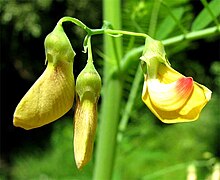Sesbania
| Sesbania | ||||||||||||
|---|---|---|---|---|---|---|---|---|---|---|---|---|

|
||||||||||||
| Systematics | ||||||||||||
|
||||||||||||
| Scientific name of the tribe | ||||||||||||
| Sesbanieae | ||||||||||||
| Rydb. | ||||||||||||
| Scientific name of the genus | ||||||||||||
| Sesbania | ||||||||||||
| Scop. |
Sesbania is the only genus of the tribe Sesbanieae in the subfamily Pea (Faboideae) within the family of legumes (Fabaceae). It is native to the tropics.
description

Vegetative characteristics
The Sesbania species grow as herbaceous plants , deciduous shrubs or rarely as trees . The alternate leaves are stalked and pinnate in pairs. The stipules are small or absent. The petiole and rachis are often grooved. There may be “minor leaflets”. The many stalked leaflets have a smooth edge. The thorns fall off early.
Generative characteristics
At the upper end of the branches are axillary, racemose inflorescences above an inflorescence stem . Bracts and awl-shaped bracts are obsolete. The flower stalks are thin.
The hermaphrodite, zygomorphic , five-fold flowers have a double perianth . The five sepals are bell-shaped fused with five approximately the same teeth or rarely they are almost bilobed and shorter than the calyx tube. The five hairless petals are usually pure yellow or with dots, rarely they are white, red or dark purple and rise above the calyx. The broad flag is nailed with two calluses. The two wings are crescent-shaped, elongated and eyed. The curved boat is eyed and nailed longer than the flag. Nine of the ten stamens are fused, the free one is on the flag. All anthers are the same and mostly hairless. The often stalked ovary is oblong and contains numerous ovules . The slim stylus is curved inward, ending in a capitate stigma .


The often long, linear and pencil-shaped legumes open when ripe, have transverse walls, are beaked and contain 8 to 50 seeds. The seeds have a rounded hilum.
distribution
The genus Sesbania is distributed worldwide in the tropics and subtropics . Some species are used as crops .


Systematics
Sesbania is the only genus of the tribe Sesbanieae in the subfamily Faboideae within the family of Fabaceae . The generic name Sesbania was first published in 1777 in Introductio ad Historiam Naturalem , pp. 308-309. Type species is Sesbania sesban (L.) Merr. Synonyms for Sesbania Scop. are: Agati Adans. , Darwinia Raf. , Daubentonia DC. , Daubentoniopsis Rydb. , Glottidium Desv. , Sesban Adans.
The genus Sesbania contains around 55 species. The International Legume Database lists the following species:
- Sesbania benthamiana Domin
- Sesbania bispinosa (Jacq.) W.Wight
- Sesbania brachycarpa F.Muell.
- Sesbania brevipedunculata J.B. Gillett
- Sesbania campylocarpa (Domin) NTBurb.
- Sesbania cannabina (Retz.) Pers.
- Sesbania chippendalei N.T.Burb.
- Sesbania cinerascens Baker
- Sesbania coerulescens Harms
- Sesbania concolor J.B. Gillett
- Sesbania dalzielii E. Phillips & Hutch.
- Sesbania drummondii (Rydb.) Cory
- Sesbania dummeri E. Phillips & Hutch.
- Sesbania emerus (Aubl.) Urb.
- Sesbania erubescens (Benth.) NTBurb.
- Sesbania exasperata Kunth
- Sesbania formosa (F.Muell.) NTBurb.
- Sesbania goetzei Harms
- Sesbania grandiflora (L.) Pers.
- Sesbania greenwayi J.B. Gillett
- Sesbania hepperi J.B.Gillett
- Sesbania herbacea (Mill.) McVaugh
- Sesbania hirtistyla J.B.Gillett
- Sesbania hobdyi Degener & Degener
- Sesbania javanica Miq.
- Sesbania keniensis J.B. Gillett
- Sesbania leptocarpa DC.
- Sesbania longifolia DC.
- Sesbania macowaniana Schinz
- Sesbania macrantha E. Phillips & Hutch.
- Sesbania macroptera Micheli
- Sesbania madagascariensis Du Puy & Labat
- Sesbania microphylla E. Phillips & Hutch.
- Sesbania notialis J.B.Gillett
- Sesbania pachycarpa DC.
- Sesbania paucisemina J.B. Gillett
- Sesbania procumbens (Roxb.) Wight & Arn.
- Sesbania punicea (Cav.) Benth.
- Sesbania quadrata J.B. Gillett
- Sesbania rostrata Bremek. & Oberm.
- Sesbania sericea (Willd.) Link
- Sesbania sesban (L.) Merr.
- Sesbania simpliciuscula Benth.
- Sesbania somaliensis J.B. Gillett
- Sesbania speciosa Deaf.
- Sesbania sphaerosperma Welw.
- Sesbania subalata J.B.Gillett
- Sesbania sudanica J.B. Gillett
- Sesbania tetraptera Baker
- Sesbania tomentosa Hook. & Arn.
- Sesbania transvaalensis J.B. Gillett
- Sesbania uliginosa Sweet
swell
- Hang Sun & Bruce Bartholomew: Sesbanieae in the Flora of China, Volume 10, 2010, p. 313: Online.
- SI Ali: Papilionaceae in the Flora of Pakistan : Sesbania - Online at efloras.org.
Individual evidence
- ↑ Entry at GRIN.
- ↑ ILDIS. , accessed November 3, 2008.



